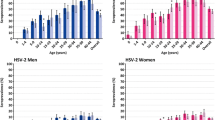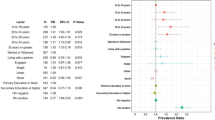Abstract
Objectives
Understanding the regional epidemiology of genital Herpes Simplex Virus (HSV) infections is important for clinical and public health practice, due to the increasing availability of type-specific serologic testing in Canada and the contribution of genital HSV-2 infection to ongoing HIV transmission. We used centralized laboratory data to describe trends in viral identifications of genital HSV in BC and assess the utility of these data for ongoing population surveillance.
Methods
Records of viral identifications (1997–2005) were extracted from the Provincial Public Health Microbiology & Reference Laboratory database. Classification as genital or other site was based on documented specimen site. We conducted a descriptive analysis of trends over time, and calculated odds of HSV-1 infection among individuals with genital herpes.
Results
Of 48,183 viral identifications, 56.8% were genital, 10.0% were peri-oral and 9.1% cutaneous; site was unknown for 22.9%. Among genital identifications, HSV-1 infection was more likely in females, younger age groups, and later time periods. The proportion of genital herpes due to HSV-1 increased over time from 31.4% to 42.8% in BC.
Conclusions
Our analysis of population-level laboratory data demonstrates that the proportion of genital herpes due to HSV-1 is increasing over time in BC, particularly among women and younger age groups; this has implications for clinical practice including the interpretation of type-specific serology. Provincial viral identification data are useful for monitoring the distribution of genital HSV-1 and HSV-2 infections over time. Improving clinical documentation of specimen site would improve the utility of these data.
Résumé
Objectifs
En raison de la disponibilité croissante du dépistage sérologique spécifique de type au Canada et du rôle de l’infection génitale à HSV-2 dans la transmission continue du VIH, il est important, pour les cliniciens et les praticiens de la santé publique, de connaître l’épidémiologie régionale des infections par le virus herpès simplex génital (HSV). À l’aide de données de laboratoire centralisées, nous décrivons les tendances des identifications virales de l’herpès génital en Colombie-Britannique et nous évaluons l’utilité de ces données pour la surveillance continue de l’herpès dans la population.
Méthode
Les dossiers d’identifications virales (1997–2005) sont extraits de la base de données Provincial Public Health Microbiology & Reference Laboratory. Notre classification des infections (génitales ou d’autres sites) est basée sur le site de prélèvement indiqué en dossier. Nous avons effectué une analyse descriptive des tendances au fil du temps et calculé les probabilités d’infection à HSV-1 chez les sujets atteints d’herpès génital.
Résultats
Sur 48 183 identifications virales, 56,8 % étaient génitales, 10 % étaient péribuccales, et 9,1 % étaient cutanées; dans 22,9 % des cas, le site n’était pas indiqué. Parmi les identifications génitales, l’infection à HSV-1 était plus probable chez les femmes, dans les groupes d’âge les plus jeunes et durant les périodes plus tardives. La proportion d’herpès génital dû à HSV-1 a augmenté au fil du temps en Colombie-Britannique, passant de 31,4 % à 42,8 %.
Conclusion
Notre analyse des données de laboratoire en population montre que la proportion de l’herpès génital dû à HSV-1 s’accroît au fil du temps en Colombie-Britannique, tout particulièrement chez les femmes et les jeunes, ce qui a des conséquences pour la pratique clinique, y compris l’interprétation de la sérologie spécifique de type. Les données provinciales des identifications virales sont utiles pour surveiller la distribution des infections génitales à HSV-1 et à HSV-2 au fil du temps. En améliorant la consignation du site de prélèvement dans les dossiers cliniques, on rehausserait l’utilité de ces données.
Similar content being viewed by others
References
Mertz KJ, Trees D, Levine WC, Lewis JS, Litchfield B, Pettus KS, et al. Etiology of genital ulcers and prevalence of human immunodeficiency virus coin-fection in 10 US cities. The Genital Ulcer Disease Surveillance Group. J Infect Dis 1998;178:1795–98.
Corey L, Wald A. Genital herpes. In: Holmes K, Sparling P, Stamm WE, et al. (Eds.). Sexually Transmitted Diseases. New York, NY: McGraw Hill, 2008; 399–437.
Tao G, Kassler WJ, Rein DB. Medical care expenditures for genital herpes in the United States. Sex Transm Dis 2000;27:32–38.
Romanowski B, Zdanowicz YM, Owens ST. In search of optimal genital herpes management and standard of care (INSIGHTS): Doctors’ and patients’ perceptions of genital herpes. Sex Transm Inf 2008;84:51–56.
Kropp RY, Wong T, Cormier L, Ringrose A, Burton S, Embree JE, et al. Neonatal herpes simplex virus infections in Canada: Results of a 3-year national prospective study. Pediatrics 2006;117:1955–62.
Freeman EE, Weiss HA, Glynn JR, Cross PL, Whitworth JA, Hayes RJ. Herpes simplex virus 2 infection increases HIV acquisition in men and women: Systematic review and meta-analysis of longitudinal studies. AIDS 2006;20:73–83.
Celum C, Wald A, Hughes J, Sanchez J, Reid S, Delany-Moretlwe S, et al. Effect of aciclovir on HIV-1 acquisition in herpes simplex virus 2 seropositive women and men who have sex with men: A randomised, double-blind, placebo-controlled trial. Lancet 2008;371:2109–19.
Watson-Jones D, Weiss HA, Rusizoka M, Changalucha J, Baisley K, Mugeye K, et al. Effect of herpes simplex suppression on incidence of HIV among women in Tanzania. N Engl J Med 2008;358:1560–71.
Corey L, Handsfield HH. Genital herpes and public health: Addressing a global problem. JAMA 2000;283:791–94.
Hook EW, Leone P. Time to translate new knowledge into practice: A call for a national genital herpes control program. J Infect Dis 2006;194:6–7.
Ratnam S, Severini A, Zahariadis G, Petric M, Romanowski B. The diagnosis of genital herpes - beyond culture: An evidence-based guide for the utilization of polymerase chain reaction and herpes simplex virus type-specific serology. Can J Infect Dis Med Micro 2007;18:233–40.
Xu F, Sternberg MR, Kottiri BJ, McQuillan GM, Lee FK, Nahmias AJ, et al. Trends in herpes simplex virus type 1 and type 2 seroprevalence in the United States. JAMA 2006;296:964–73.
Patrick DM, Dawar M, Cook DA, Krajden M, Ng HC, Rekart ML. Antenatal seroprevalence of herpes simplex virus type 2 (HSV-2) in Canadian women: HSV-2 prevalence increases throughout the reproductive years. Sex Transm Dis 2001;28:424–28.
Singh AE, Romanowski B, Wong T, Gourishankar S, Myziuk L, Fenton J, et al. Herpes simplex virus seroprevalence and risk factors in 2 Canadian sexually transmitted disease clinics. Sex Transm Dis 2005;32:95–100.
Howard M, Sellors JW, Jang D, Robinson NJ, Fearon M, Kaczorowski J, et al. Regional distribution of antibodies to herpes simplex virus type 1 (HSV-1) and HSV-2 in men and women in Ontario, Canada. J Clin Microbiol 2003;41:84–89.
Forward K, Lee S. Predominance of herpes simplex virus type 1 from patients with genital herpes in Nova Scotia. Can J Infect Dis 2003;14:94–96.
Gray E, Morgan J, Lindeman J. Herpes simplex type 1 versus Herpes simplex type 2 in anogenital herpes; a 10 year study from the Waikato region of New Zealand. N Z Med J 2008;121:43–50.
Haddow LJ, Dave B, Mindel A, McPhie KA, Chung C, Marks C, et al. Increase in rates of herpes simplex virus type 1 as a cause of anogenital herpes in western Sydney, Australia, between 1979 and 2003. Sex Transm Infect 2006;82:255–59.
Manavi K, McMillan A, Ogilvie M. Herpes simplex virus type 1 remains the principal cause of initial anogenital herpes in Edinburgh, Scotland. Sex Transm Dis 2004;31:322–24.
Ribes JA, Steele AD, Seabolt JP, Baker DJ. Six-year study of the incidence of herpes in genital and nongenital cultures in a central Kentucky medical center patient population. J Clin Microbiol 2001;39:3321–25.
Scoular A, Norrie J, Gillespie G, Mir N, Carman WF. Longitudinal study of genital infection by herpes simplex virus type 1 in Western Scotland over 15 years. BMJ 2002;324:1366–67.
Tran T, Druce JD, Catton MC, Kelly H, Birch CJ. Changing epidemiology of genital herpes simplex virus infection in Melbourne, Australia, between 1980 and 2003. Sex Transm Infect 2004;80:277–79.
Lafferty WE, Downey L, Celum C, Wald A. Herpes simplex virus type 1 as a cause of genital herpes: Impact on surveillance and prevention. J Infect Dis 2000;181:1454–57.
Engleberg R, Carrell D, Krantz E, Corey L, Wald A. Natural history of genital herpes simplex virus type 1 infection. Sex Transm Dis 2003;30:174–77.
Langenberg AG, Corey L, Ashley RL, Leong WP, Straus SE. A prospective study of new infections with herpes simplex virus type 1 and type 2. Chiron HSV Vaccine Study Group. N Engl J Med 1999;341:1432–38.
The UK Collaborative Group for HIV and STI Surveillance. Testing Times. HIV and Other Sexually Transmitted Infections in the United Kingdom: 2007. London, Health Protection Agency, Centre for Infections, 2007).
Sexually Transmitted Disease Surveillance 2007. Division of STD Prevention, Department of Health and Human Services, Centers for Disease Control and Prevention, Atlanta, Georgia, 2008).
Roberts CM, Pfister JR, Spear SJ. Increasing proportion of herpes simplex virus type 1 as a cause of genital herpes infection in college students. Sex Transm Dis 2003;30:797–800.
Ryder N, Jin F, McNulty A, Grulich AE, Donovan B. Increasing role of herpes simplex virus type 1 in first-episode anogenital herpes in heterosexual women and younger men who have sex with men, 1992–2006. Sex Transm Infect 2009;85:416–19.
Lowhagen GB, Tunback P, Andersson K, Bergstrom T, Johannisson G. First episodes of genital herpes in a Swedish STD population: A study of epidemiology and transmission by the use of herpes simplex virus (HSV) typing and specific serology. Sex Transm Infect 2000;76:179–82.
Author information
Authors and Affiliations
Corresponding author
Rights and permissions
About this article
Cite this article
Gilbert, M., Li, X., Petric, M. et al. Using Centralized Laboratory Data to Monitor Trends in Herpes Simplex Virus Type 1 and 2 Infection in British Columbia and the Changing Etiology of Genital Herpes. Can J Public Health 102, 225–229 (2011). https://doi.org/10.1007/BF03404902
Received:
Accepted:
Published:
Issue Date:
DOI: https://doi.org/10.1007/BF03404902




